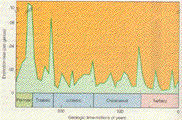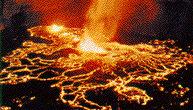Patterns of Extinction
 Several mass extinctions have occurred throughout earth history. Cycles found to be associate with these events has resulted in paleontologists proposing mechanisms to explain these events. It seems that mass extinctions occur at regular time intervals with a periodicity of approximately 26 million years. This concept was first suggested by Alfred Fischer and Michael Arthur, but has been further expanded upon by various researchers utilizing data collected by David Raup and John Sepkoski. Raup and Sepkoski constructed graphs utilizing incidences of extinction of marine families through time. The rate of extinction was represented on a graph as a series of rising and falling peaks. Surprisingly, these peaks coincided with most major events of extinction throughout earth history. However, a significant number of paleontologists believe Raup and Sepkoski's research to be flawed, arguing that the dates used in the study are incorrect, and that the spacing pattern is not always 26 million years. Until new evidence can be brought forth, the question of periodicity will clearly remain a source of debate within the paleontological community.
Several mass extinctions have occurred throughout earth history. Cycles found to be associate with these events has resulted in paleontologists proposing mechanisms to explain these events. It seems that mass extinctions occur at regular time intervals with a periodicity of approximately 26 million years. This concept was first suggested by Alfred Fischer and Michael Arthur, but has been further expanded upon by various researchers utilizing data collected by David Raup and John Sepkoski. Raup and Sepkoski constructed graphs utilizing incidences of extinction of marine families through time. The rate of extinction was represented on a graph as a series of rising and falling peaks. Surprisingly, these peaks coincided with most major events of extinction throughout earth history. However, a significant number of paleontologists believe Raup and Sepkoski's research to be flawed, arguing that the dates used in the study are incorrect, and that the spacing pattern is not always 26 million years. Until new evidence can be brought forth, the question of periodicity will clearly remain a source of debate within the paleontological community.
 The concept of periodicity has important implications for determining which factors cause extinction. Hypotheses invoking catastrophism have particularly been advanced utilizing this concept, which imply extra-terrestrial forces as extinction-causing agents. This is because only astronomical forces are known to operate on such a precise periotic time schedule. Contrary to catastrophism are hypotheses which focus on gradualism. These gradualistic hypotheses invoke various terrestrial extinction mechanisms including volcanism, glaciation, global climatic change, and changes in sea level. Most recently hypotheses centered on the new non-linear science of complexity have emerged. Under these hypotheses species-species interactions lead to occasional instability resulting in cascades which may ripple through entire ecosystems, with potentially devastating results.
The concept of periodicity has important implications for determining which factors cause extinction. Hypotheses invoking catastrophism have particularly been advanced utilizing this concept, which imply extra-terrestrial forces as extinction-causing agents. This is because only astronomical forces are known to operate on such a precise periotic time schedule. Contrary to catastrophism are hypotheses which focus on gradualism. These gradualistic hypotheses invoke various terrestrial extinction mechanisms including volcanism, glaciation, global climatic change, and changes in sea level. Most recently hypotheses centered on the new non-linear science of complexity have emerged. Under these hypotheses species-species interactions lead to occasional instability resulting in cascades which may ripple through entire ecosystems, with potentially devastating results.
 Click here to view Mass Extinctions of the Phanerozoic menu
Click here to view Mass Extinctions of the Phanerozoic menu
 Click here to return to the Main Menu
Click here to return to the Main Menu